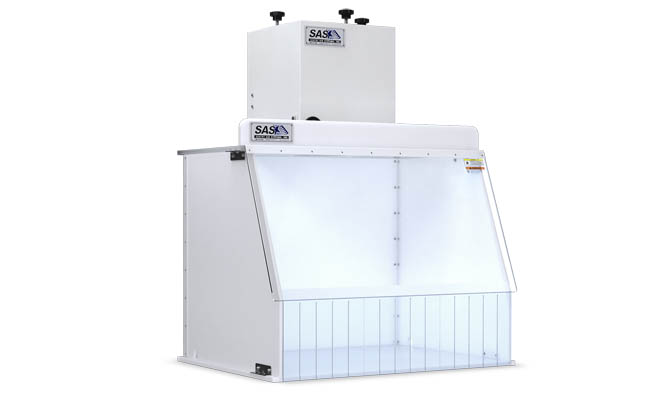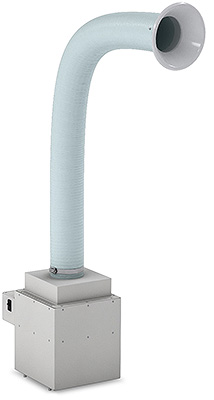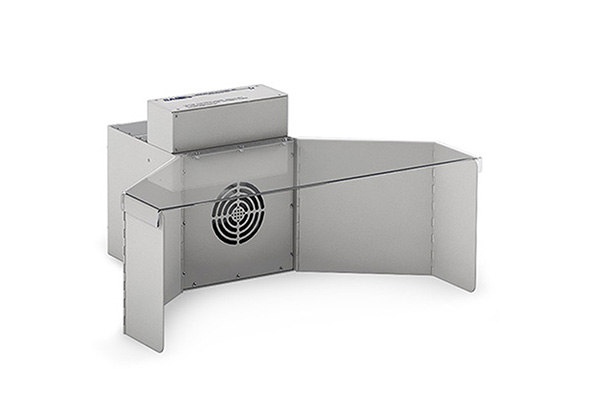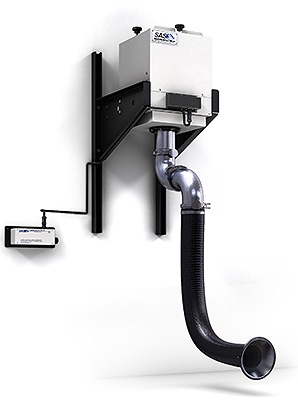Formaldehyde Fumes
Formaldehyde fumes are produced from the use of various residential and industrial products that utilize formaldehyde in its makeup. This volatile organic compound (VOC) is nondetecable to the naked eye, yet can be recognized by its pungent smell, and can pollute the immediate environment if not properly handled. Due to its widespread use and carcinogenic properties, formaldehyde must be carefully handled, applicable workspace air levels monitored, and those work areas properly ventilated to prevent respiratory and direct contact. Exposure of formaldehyde can lead to irritations, neurological effects, and cancer.

Fume Hoods
Ductless fume hoods, or filtered fume hoods, are self-contained, filtered enclosures that remove hazardous fumes, vapors and particulates from the immediate environment. Typically used in locations where outside ventilation cannot suffice, a ductless fume hood is a necessity to eliminate high percentages of harmful contaminants to protect users, applications and the atmosphere.
There are a few key characteristics that distinguish Ductless Fume Hoods from Conventional Ducted Fume Hoods (that typically vent outdoors):
- A “recirculating” air pattern and no external ducting or venting.
- The use of high-quality filtration media.
- Benefits including environmentally-friendly operation, energy efficiency, cost efficiency, minimal maintenance, and mobility.

Portable Extractor
The Portable Floor Sentry fume extractor is a safety engineering control used for the capture and filtration of airborne contaminants. This source-capture fume extractor features heavy-duty casters for easy mobility, a flame-retardant and self-supportive flex arm, a small footprint, and high-quality filtration media.
Several filter media options are available for this unit and include: HEPA filtration [up to 99.97% efficient on particles 0.3 microns and larger, ASHRAE filtration [up to 95% efficient on particles 0.5 microns and larger], Activated Carbon, and specialty-blended filter media [i.e. Acid Gas, Mercury, Aldehyde, Ammonia]. The Portable Floor Sentry Fume Extractor allows multiple filter media to be housed inside the filter chamber for applications that emit both particulates and fumes.

Winged Extractor
The Winged Sentry is a compact benchtop air filtration system that provides a highly energy-efficient, quiet and economical solution to many fume extraction needs. It features adjustable "wing flaps" to assist in directing fumes towards the unit's inlet and into the filter chamber. The operator can place these wings in the most effective position for their particular application, or they can be positioned flat against the sides of the unit to conserve space.
Appropriate filtration media is installed in the Winged Sentry based on the application being performed by the operator. HEPA [up to 99.97% efficient on particles 0.3 microns and larger], ASHRAE [up to 95% efficient on particles 0.5 microns and larger], Activated Carbon, and specialty-blended media [i.e. Acid Gas, Mercury, Aldehyde, Ammonia] are the most common filters for this unit.

Wall Mounted
The wall mounted fume extractor is a uniquely engineered air filtration system that is built specifically for small or limited workspace environments where air purification is desired. This source capture system features a free-hanging, self-supportive flex arm that can easily be maneuvered by the operator to their desired location.
This fume extractor combines quiet operation, energy-efficient technology, and a unique mounting option that creates an effective solution for many applications that require fume and particulate removal.
Formaldehyde Exposure
Formaldehyde exposure occurs from the inhalation of formaldehyde vapors, skin absorption from direct contact of liquid formaldehyde, or the ingestion of foods containing formaldehyde. According to the Agency of Toxic Substances and Disease Registry, inhalation of formaldehyde fumes happens from breathing air in areas of formaldehyde gas release including industrial processes that use formaldehyde, wood products, carpets, car exhaust, cigarette smoke, and paints and varnishes. Direct contact with formaldehyde predominately occurs at an occupational level in professions that handle formaldehyde containing solutions.
Many occupations have a higher risk of formaldehyde exposure through inhalation and direct contact including:
- Dentists
- Doctors
- Embalmers
- Formaldehyde resin-based industries
- Pathologists
- Veterinarians
- Nurses
- Teachers and students while handling preserved specimens
Consumers can become exposed to formaldehyde mainly through the emission of formaldehyde vapors from household building materials and fuel burning appliances. Household building materials treated with formaldehyde emit amounts of formaldehyde fumes into the air. Fuel-burning appliances such as gas stoves, wood-burning stoves, and kerosene heaters produce concentrations of formaldehyde gas in the home. Formaldehyde gas VOCs contaminate the indoor air and overtime can exceed safe exposure levels. Other products such as food and cosmetics contain small amounts of formaldehyde that cause little effects.
Formaldehyde Exposure Limit
Formaldehyde exposure limits are regulated to ensure employee and consumer protection by the Occupational Safety and Health Administration (OSHA), National Institute of Occupational Safety and Health (NIOSH), and the Environmental Protection Agency (EPA). The chart below summarizes the occupational exposure limit set by OSHA and NIOSH.
| OSHA | 0.75 ppm | 0.5 ppm |
| NIOSH | 0.016 ppm | 0.1 ppm |
OSHA requires all employers to keep occupational formaldehyde exposure below the permissible exposure limit (PEL) of 0.75 ppm. This value is as a time-weighted average over an eight-hour workday. For the 15-minute short term exposure limit (STEL), formaldehyde concentrations must not exceed 2 ppm. Employers must conduct air sampling of workspaces and if formaldehyde air concentrations exceed the action level 0.5 ppm, engineering controls must be installed to maintain air concentrations of formaldehyde below the PEL.
Although not legally enforced, NIOSH suggests a recommended exposure level (REL) for formaldehyde of 0.016 ppm with a short term exposure limit of 0.1 ppm. This much lower limit of exposure ensures the most protection against any health side effects. Studies have shown that at even formaldehyde concentrations of 0.1 to 0.5 ppm can cause health side effects.
The EPA dictates the exposure limit of formaldehyde produced from the emissions of pressed wood products including hardwood plywood, medium-density fiberboard (MDF), and particleboard. The Formaldehyde Standards for Composite Wood Products Act set emission standards to limit household indoor air formaldehyde concentrations. Under this ruling manufacturers, importers, fabricators, distributors, and retailers must only use products with composite wood certified to be compliant with the emission standards. Third-party certifiers test and check for compliance of all composite wood material. The chart below showcases the emission standards for all applicable products:
| Hardwood Plywood – Veneer Core | 0.05 ppm of formaldehyde |
| Hardwood Plywood – Composite Core | 0.05 ppm of formaldehyde |
| Medium-Density Fiberboard | 0.11 ppm of formaldehyde |
| Thin Medium-Density Fiberboard | 0.13 ppm of formaldehyde |
| Particleboard | 0.09 ppm of formaldehyde |
Formaldehyde Exposure Symptoms
Formaldehyde exposure can produce health symptoms depending on the method and concentration of formaldehyde exposure. After ingesting or inhaling formaldehyde, the body breaks down the majority of the compound and formaldehyde only enters the bloodstream when exposed to high levels. Formaldehyde fumes can be converted into carbon monoxide and leave the body. Small amounts of formaldehyde can be found in foods and cosmetics but generally do not cause any health side effects. However, formaldehyde fume exposure through inhalation can irritate the entry point of the body such as the eyes, nose, and throat. Workers can become sensitized to formaldehyde leading to allergic reactions and asthma-like symptoms. Likewise, inhalation formaldehyde can lead to neurological effects such as decreased short-term memory. Certain individuals may be more sensitive to formaldehyde vapors and experience symptoms at a concentration of formaldehyde, while others may not experience any symptoms.
Direct contact of formaldehyde to the skin can produce dermatitis, rashes, and itching. If formaldehyde direct contact occurs to the eyes, the individual may experience eye damage or blindness.
Similarly, formaldehyde has been classified as a human carcinogen by the Department of Health and Human Services (DHHS) and the International Agency for Research on Cancer (IARC). Cancer from formaldehyde exposure occurs mainly in the entrance area of the body such as the nose and throat. However, some industrial workers and embalmers have developed myeloid leukemia from formaldehyde fume exposure.
Exposure Control
To control formaldehyde fumes exposure, OSHA recommends implementing engineering control methods such as ventilation systems or fume extractors. Source capture fume extraction works the most efficiently for formaldehyde use in industrial applications. Sentry Air Systems offers a wide range of ductless source capture fume extractors and fume hood systems for proper fume control. Ductless systems fitted with aldehyde specialty blended activated carbon filtration help protect the environment from formaldehyde pollution. In an industrial hygienist conducted testing of our aldehyde specialty blended activated carbon filters, our systems equipped with the filter exhibited 99.33% efficiency (efficiency is not guaranteed and depends on the application). In contrast, the standard activated carbon filters had an efficiency rating of 95.45%. These specialty blended filters undergo processing to make the treated activated carbon more effective at filtration than untreated activated carbon. Specialty-blended activated carbon filters use chemisorption to more productively remove the chemical from the airflow. The treated activated carbon causes a chemical reaction between the contaminant and the specialty blend on the carbon to create a new chemical bond removing it from the airflow. The chemical formula for the treatment depends on the application and the chemicals in use. For indoor air cleaning, our air cleaners protect against formaldehyde emission and concentration of formaldehyde build up inside homes, offices, and other buildings

 Made in the USA
Made in the USA